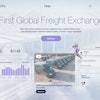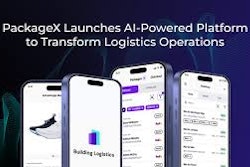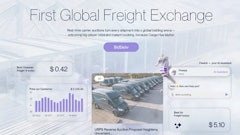
Intermodal terminals experienced significant volume growth in 2024, according to the Intermodal Association of North America, increasing 8.5% compared to the previous year. The growth was primarily driven by a 13.9% surge in international container movements, which can create inefficiencies and increased costs for terminals. Terminal operators faced added operational complexity, congestion, and bottlenecks due to factors like increased dwell times and limited yard capacity.
As container volumes continue to grow, data has become more critical to helping terminals navigate daily challenges. Operational reporting and dashboards immediately come to mind in such contexts, but staying competitive today requires more—tools that are more insightful, predictive, and actionable. Better governance, usage, and application of a terminal’s data can increase efficiency and decrease costs while minimizing capital investment in infrastructure. But where does one begin, and what should be prioritized as we embark on this new data-inspired journey?
Understanding data
Terminal operating systems (TOS) and the myriad of other technologies in use at a terminal generate a vast amount of data. Much of it is transactional, which is generated from an event or activity such as in-gates, equipment moves, train arrivals, and demurrage payments. It is often related to master data, which is relatively stable over time and core to operations, such as assets like chassis, containers, terminal layouts, container types, and customer information like BCOs.
Then, there’s operational data like yard inventory, equipment status, and shift schedules. Add in log data from sensors, TOS, and security logs, and one can quickly become overwhelmed by the sheer volume and complexity. Much of this data is used to calculate analytics for reporting, performance measurement, and decision-making.
What it means to be real-time
Many terminals will extract a limited subset of that data, feed it into a data warehouse, and use it to produce reports. That’s a bit like driving to a national park in a neighboring state using a printed map. You can plan your route based on the roads as they existed when the map was printed and estimate travel time by distance, but that’s about it. The information is static and useful for some planning, analytics, and identifying long-term trends.
Now, let’s compare that to GPS navigation. The system suggests a route based on real-time traffic, accidents, and road closures for optimal navigation. You know exactly when to turn, onto which road, and how much longer the trip will take based on not only distance but factors like speed limits and even weather. You’re warned about upcoming congestion and receive suggested shortcuts with an estimate of potential time savings. You can configure whether you want to take toll roads, avoid highways, or add some stopovers. The information updates in real-time for immediate impact and optimizes every second of your route.
Who wants to go back to the 1990s? Using GPS over a paper map is not a difficult choice but requires a more sophisticated approach. For intermodal terminals, it means feeding all the different types of data into something more than a data warehouse.
Employing data strategies for better decision-making
If integrating real-time data into the right database is the first step, the next challenge is data quality. If the container positions in your system are accurate only 75% of the time, any analysis or decisions based on them will have low reliability.
Begin by identifying the critical master data for terminal operations and appoint a data steward to oversee its governance and accuracy. Perhaps start with 20 data elements and then increase it over time. The goal isn’t to achieve 100% data coverage or accuracy but to ensure the data-driving KPIs and decisions are based on reliable information.
Optimizing operations
With these three elements in place – real-time data, a transactional data platform, and data governance - one can begin to deploy predictive analytics to forecast congestion and dwell time, optimize train slots, and anticipate equipment failures, for example. Leveraging machine learning (ML) develops and continuously refines decision models based on your data, providing detailed, granular insights into your operations.
Once a strong data foundation is in place, artificial intelligence (AI) can be leveraged for dynamic decision-making, enabling real-time optimization of terminal operations. For example, AI can automate gate scheduling, yard planning, and equipment allocation, ensuring that resources are utilized efficiently and adapting to changing conditions.
AI operates by continuously receiving live data from the data platform as events unfold. It processes this information using ML models, identifying patterns, predicting outcomes, and making informed decisions. These decisions are then seamlessly fed back into the TOS, triggering automated actions such as equipment dispatch, priority adjustments, or optimized container placements.
This approach marks a significant shift from traditional planning, where terminal operations rely on a static plan created at the start of the day, to an AI-driven system that dynamically adjusts in real-time as conditions change.
Beyond real-time decision-making, AI also enables the use of digital twins and simulation models to test different operational scenarios. By creating a virtual replica of terminal operations, operators can simulate various conditions, evaluate potential bottlenecks, and refine strategies before implementing changes in the live environment. This proactive approach enhances efficiency, reduces risk, and supports continuous process improvement across the terminal.
Balancing AI with human insights
That’s a lot of technology, and as with any new system, adoption can be a challenge. Operators and planners may be hesitant to trust AI-driven recommendations after years of relying on experience and instinct. How do we bridge the gap between trusting technology, providing feedback, and refining it to maximize efficiency?
This is where the yard strategist plays a crucial role. Acting as the link between technology and terminal operations, the yard strategist ensures that AI-driven decisions align with real-world conditions, identifying opportunities for improvement and fine-tuning the system’s logic.
But even the best strategist needs the right tools. A modern yard management application serves as a command center, offering a bird’s-eye view of all current and pending decisions. This system integrates real-time data, machine learning insights, and human input. It enables strategists to gain clear visibility into AI-driven recommendations and compare them with current operations to make informed overrides when necessary. Over time, this blend of accurate data, real-time analytics, and balanced insights improves yard strategies.
By embracing both the role of a yard strategist and an intelligent decision-support system, intermodal terminals can transition from static, manual planning to dynamic, AI-enhanced optimization, ensuring greater efficiency, fewer bottlenecks, and improved throughput.
Preparing for volume growth
Real-time data and data strategies leveraging a modern data platform will revolutionize intermodal rail terminals by giving them the power to make smart decisions in real-time. AI-driven decision-making can optimize such tasks as gate scheduling, yard planning, and equipment allocation. By constantly processing live data, AI can adjust operations on the fly, reducing delays and boosting efficiency. Combining real-time visibility, predictive insights, and automation will better enable intermodal terminals to speed up turnaround times, reduce congestion, and recover from disruptions faster.




















